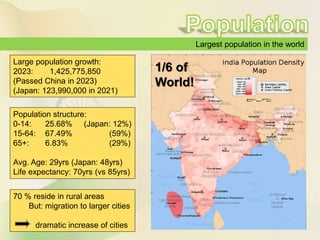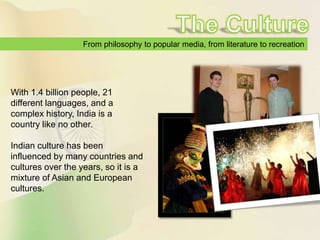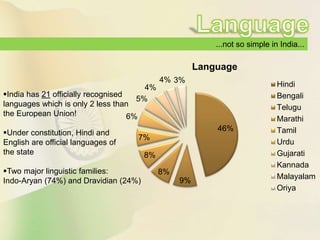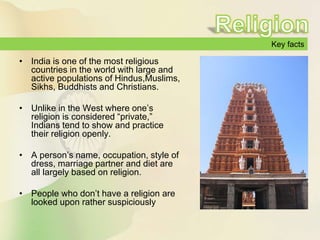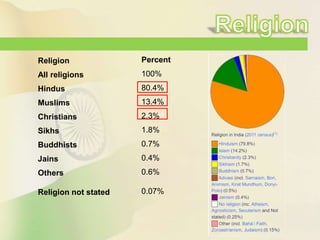An Introduction to India and its Culture
- 2. The Indian Subcontinent ŌĆó7th largest country in the world with 3.287.263 km2 ŌĆóCoastline: 7517 km ŌĆó 8X the size of Japan! ŌĆóHimalaya (north) ŌĆóLargest river: Ganges Ganges-Brahmaputra (agricultural) ŌĆóThar desert (west) ŌĆóTropical with rainforest (south) Main cities: ŌĆóNew Dehli ŌĆóMumbai (Bombay) ŌĆóKolkata (Calcutta) MYANMAR
- 3. Kashmir conflict Dispute over the Kashmir territory by India, Pakistan, China and the people of Kashmir India: Kashmir is an "integral part" of India Pakistan: Kashmir is a disputed territory whose final status must be determined by the people of Kashmir Kashmiri independence groups: Kashmir should be independent China: controls 20% of Kashmir since 1962
- 4. Very different climatic zones Six major climate areas from... ..desert in the west.. ..Alpine tundra and glaciers in the north.. ŌĆ”Humid tropical regions with rainforest in the southwest.
- 5. Largest population in the world Large population growth: 2023: 1,425,775,850 (Passed China in 2023) (Japan: 123,990,000 in 2021) Population structure: 0-14: 25.68% (Japan: 12%) 15-64: 67.49% (59%) 65+: 6.83% (29%) Avg. Age: 29yrs (Japan: 48yrs) Life expectancy: 70yrs (vs 85yrs) 70 % reside in rural areas But: migration to larger cities dramatic increase of cities 1/6 of World!
- 6. From philosophy to popular media, from literature to recreation With 1.4 billion people, 21 different languages, and a complex history, India is a country like no other. Indian culture has been influenced by many countries and cultures over the years, so it is a mixture of Asian and European cultures.
- 7. ...not so simple in India... 46% 9% 8% 8% 7% 6% 5% 4% 4% 3% Language Hindi Bengali Telugu Marathi Tamil Urdu Gujarati Kannada Malayalam Oriya ’é¦India has 21 officially recognised languages which is only 2 less than the European Union! ’é¦Under constitution, Hindi and English are official languages of the state ’é¦Two major linguistic families: Indo-Aryan (74%) and Dravidian (24%)
- 8. Key facts ŌĆó India is one of the most religious countries in the world with large and active populations of Hindus,Muslims, Sikhs, Buddhists and Christians. ŌĆó Unlike in the West where oneŌĆÖs religion is considered ŌĆ£private,ŌĆØ Indians tend to show and practice their religion openly. ŌĆó A personŌĆÖs name, occupation, style of dress, marriage partner and diet are all largely based on religion. ŌĆó People who donŌĆÖt have a religion are looked upon rather suspiciously
- 9. Religion not stated Others Jains Buddhists Sikhs Christians Muslims Hindus All religions Religion 0.07% 0.6% 0.4% 0.7% 1.8% 2.3% 13.4% 80.4% 100% Percent
- 10. Culturally Rich Inventions ŌĆóThe digit zero and the numbering system ( Aryabhatta) ŌĆóChess ŌĆó Algebra, Trigonometry, and Calculus ŌĆó The decimal system ŌĆó The game of Snakes and Ladders ŌĆó The value of
- 11. Salwar Kameez ! ’é¦Indian women have a variety of different apparel and styles to choose from, but three of the most common garments are: 1. Sari 2. Salwar Kameez 3. Choli ’é¦Men too have many options and here are but three samples: 1. Dhoti 2. Lungi 3. Kurta
- 12. How to eat Indian food ŌĆóIndian food is often eaten with the hands ŌĆóconsidered impolite to allow the food to pass the first joint of the fingers ŌĆófingers should never touch the mouth directly ŌĆóonly the right hand may be used in eating ŌĆóspoon is provided for soup, but the bread may even be used to eat that ŌĆóMeat may be eaten with a knife and fork, but it will more often be served pre-cut, so it may be easily managed by the fingers
- 13. How to eat Indian food
- 14. Sports, Sports, Sports ŌĆóOfficial national sport is Hockey ŌĆóMany indoor and outdoor games such as snakes and ladders, playing cards, polo etc. ŌĆóMost popular sport: cricket
- 15. ŌĆó Business ŌĆó Engineer ŌĆó MBA ŌĆó Doctor ŌĆó Accountants From Dreams to Reality....
- 16. ŌĆó Elementary Education ŌĆō Fundamental Right ŌĆó More than 1700 Colleges, 350 Universities and 20 Institutes of National Importance ŌĆó But Literacy Rate ŌĆō 65.38% ŌĆó Female Literacy ŌĆō 54.16% ŌĆó Urban Literacy ŌĆō 80.3%
- 17. Traditional vs. Modern Ferrari vs.. Oxcart Western modern life vs.. Tradtional families Modern appartments vs.. Slums.





